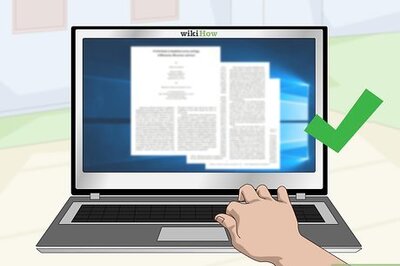
views
Tokyo: Japan has asked Russia to send a floating radiation treatment plant, used to decommission nuclear submarines, which will solidify contaminated liquid waste from the country's crippled nuclear power plant, Russian media reported.
Engineers at the Fukushima Daiichi nuclear plant have been forced to release radioactive water into the sea until on Friday and have resorted to desperate measures to contain the damage, such as using bath salts as a dye to try to locate the source of leaks at the complex 240 km (150 miles) north of Tokyo.
More than three weeks after a 9.0 magnitude earthquake and massive tsunami hit northeast Japan and damaged the plant, engineers are no closer to regaining control of the facility or stopping radioactive leaks.
After seeking help from France and the United States, Japan had now asked Russia to send the floating radiation treatment plant "Suzuran", which has been used to decommission Russian submarines in nearby Vladivostock, Interfax news agency reported.
The "Suzuran", one of the world's largest liquid radioactive waste treatment plants, treats radioactive liquid with chemicals and stores it in a cement form. It is can process 35 cubic metres of liquid waste a day and 7,000 cubic metres a year.
Engineers also plan to build two giant "silt curtains" made of polyester fabric in the sea to block the spread of more contamination from the plant.
Plant operator Tokyo Electric Power Co (TEPCO) was forced on Monday to start releasing 11,500 tonnes of low-level radioactive seawater that had been used to cool overheated fuel rods after it ran out of storage capacity for more highly contaminated water.
A TEPCO official was in tears as he told a news conference: "We are very sorry for this region and those involved."
Shares of TEPCO plunged to a record low of 376 yen on Tuesday on uncertainty over the nuclear crisis.
Koichi Nakamura, a deputy director-general of Japan's Nuclear Industrial Safety Agency, told a news conference in Vienna, said Japan had not ruled out expanding a 20-km (13- mile) evacuation zone around the site.
The world's costliest natural disaster has caused power blackouts and cuts to supply chains, threatening Japan's economic growth and the operations of global firms from semiconductor makers to shipbuilders.
The world's biggest auto maker Toyota Motor Corp will idle some US factories due to supplies in Japan drying up. The company, which built nearly 1.5 million cars and trucks in North America last year, said it did not know how many of its 13 plants would be affected.
The nuclear crisis alone is likely to lead to one of the country's largest and most complex ever set of claims for civil damages, handing a huge bill to the fiscally strained government and debt-laden plant operator TEPCO.
Analysts at Bank of America Merrill Lynch estimate that claims could top $130 billion if the crisis drags on for years, with TEPCO and the Japanese government splitting the cost.
TEPCO plans to start paying compensation to evacuees and those suffered losses due to the nuclear disaster before damages have been assessed, the Yomiuri newspaper reported on Tuesday.
The quake and tsunami left nearly 28,000 people dead or missing and Japan's northeast coast a wreck.
Bath salt, sea curtain
In their desperation to stop radioactive leaks, TEPCO engineers have used anything at hand. They have mixed sawdust and newspapers with polymers and cement in an unsuccessful attempt to seal a crack in a concrete pit at reactor No.2.
On Monday, they resorted to powdered bath salts to produce a milky colour in water to help trace the source of the leak.
TEPCO said it was also planning to drape a curtain into the sea off the nuclear plant to try to prevent radioactive silt drifting out into the ocean.
The exact source of the radiation leaks remains unknown. Japan's nuclear safety agency is investigating a damaged embankment near a sluice gate at the No.2 reactor and the possibility it may be seeping through a layer of small stones below a concrete pipe.
TEPCO said it would build tanks to hold contaminated seawater, was towing a floating tank which will arrive next week, and was negotiating the purchase of three more.
Small levels of radiation from the plant have been detected as far away as Europe and the United States and several countries have banned milk and produce from the vicinity.

















Comments
0 comment